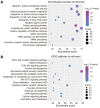Study on gene expression patterns and functional pathways of peripheral blood monocytes reveals potential molecular mechanism of surgical treatment for periodontitis
- PMID: 31363466
- PMCID: PMC6656668
- DOI: 10.12998/wjcc.v7.i12.1383
Study on gene expression patterns and functional pathways of peripheral blood monocytes reveals potential molecular mechanism of surgical treatment for periodontitis
Abstract
Background: Periodontitis is a chronic inflammation of periodontal supporting tissue caused by local factors. Periodontal surgery can change the gene expression of peripheral blood mononuclear cells. However, little is known about the potential mechanism of surgical treatment for periodontitis.
Aim: To explore the potential molecular mechanism of surgical treatment for periodontitis.
Methods: First, based on the expression profiles of genes related to surgical treatment for periodontitis, a set of expression disorder modules related to surgical treatment for periodontitis were obtained by enrichment analysis. Subsequently, based on crosstalk analysis, we proved that there was a significant crosstalk relationship between module 3 and module 5. Finally, based on predictive analysis of multidimensional regulators, we identified a series of regulatory factors, such as endogenous genes, non-coding RNAs (ncRNAs), and transcription factors, which have potential regulatory effects on periodontitis.
Results: A total of 337 genes related to surgical treatment for periodontitis were obtained, and 3896 genes related to periodontitis were amplified. Eight expression modules of periodontitis were obtained, involving the aggregation of 2672 gene modules. These modules are mainly involved in G-protein coupled receptor signaling pathway, coupled to cyclic nucleotide second messenger, and adenylate cyclase-modulating G-protein coupled receptor signaling pathway. In addition, eight endogenous genes (including EGF, RPS27A, and GNB3) were screened by network connectivity analysis. Finally, based on this set of potential dysfunction modules, 94 transcription factors (including NFKB1, SP1, and STAT3) and 1198 ncRNAs (including MALAT1, CRNDE, and ANCR) were revealed. These core regulators are thought to be involved in the potential molecular mechanism of periodontitis after surgical treatment.
Conclusion: Based on the results of this study, we can show biologists and pharmacists a new idea to reveal the potential molecular mechanism of surgical treatment for periodontitis, and provide valuable reference for follow-up treatment programs.
Keywords: Dysregulation module; Gene expression; Gene expression pattern; Peripheral blood mononuclear cells; Potential molecular mechanism.
Conflict of interest statement
Conflict-of-interest statement: The authors have no conflicts of interest to declare.
Figures



Similar articles
-
Screening of disorders associated with osteosarcoma by integrated network analysis.Biosci Rep. 2019 May 21;39(5):BSR20190235. doi: 10.1042/BSR20190235. Print 2019 May 31. Biosci Rep. 2019. PMID: 30936265 Free PMC article.
-
STAT3 speeds up progression of osteoarthritis through NF-κB signaling pathway.Exp Ther Med. 2020 Jan;19(1):722-728. doi: 10.3892/etm.2019.8268. Epub 2019 Dec 2. Exp Ther Med. 2020. PMID: 31885710 Free PMC article.
-
Identification of hydatidosis-related modules and key regulatory genes.PeerJ. 2020 Jun 18;8:e9280. doi: 10.7717/peerj.9280. eCollection 2020. PeerJ. 2020. PMID: 32596042 Free PMC article.
-
Exploring the molecular disorder and dysfunction mechanism of human dental pulp cells under hypoxia by comprehensive multivariate analysis.Gene. 2020 Apr 20;735:144332. doi: 10.1016/j.gene.2020.144332. Epub 2020 Jan 20. Gene. 2020. PMID: 31972310
-
Role of AhR and Foxo1 in skin inflammation in burn animal model via MAPK signaling pathway.Cell Mol Biol (Noisy-le-grand). 2020 May 15;66(2):53-58. Cell Mol Biol (Noisy-le-grand). 2020. PMID: 32415927
Cited by
-
Cell Proliferation and Apoptosis-Related Genes Affect the Development of Human Nasopharyngeal Carcinoma Through PI3K/AKT Signaling Pathway.Mol Biotechnol. 2021 Nov;63(11):1081-1091. doi: 10.1007/s12033-021-00357-0. Epub 2021 Jul 8. Mol Biotechnol. 2021. PMID: 34236626
References
-
- Larsson L, Thorbert-Mros S, Rymo L, Berglundh T. Interleukin-10 genotypes of the -1087 single nucleotide polymorphism influence sp1 expression in periodontitis lesions. J Periodontol. 2011;82:1376–1382. - PubMed
-
- Peng W, Deng W, Zhang J, Pei G, Rong Q, Zhu S. Long noncoding RNA ANCR suppresses bone formation of periodontal ligament stem cells via sponging miRNA-758. Biochem Biophys Res Commun. 2018;503:815–821. - PubMed
-
- Behle JH, Papapanou PN. Periodontal infections and atherosclerotic vascular disease: an update. Int Dent J. 2006;56:256–262. - PubMed
-
- van Winkelhoff AJ, Winkel EG, Vandenbroucke-Grauls CM. [Periodontitis: a hidden chronic infection] Ned Tijdschr Geneeskd. 2001;145:557–563. - PubMed
LinkOut - more resources
Full Text Sources
Miscellaneous

